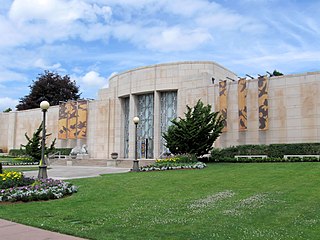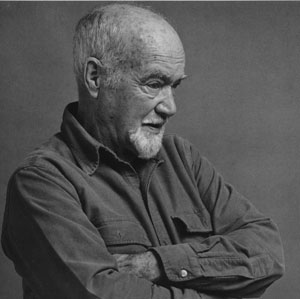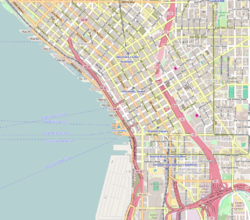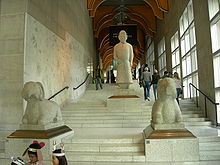Washington Mutual, Inc. was an American savings bank holding company based in Seattle. It was the parent company of WaMu Bank, which was the largest savings and loan association in the United States until its collapse in 2008.
Safeco Insurance is an American insurance company based in Seattle. A subsidiary of Liberty Mutual, Safeco provides auto insurance, homeowners insurance, and liability insurance. The company name is an acronym for Selective Auto and Fire Ensurance Company of America, or SAFECO.

Downtown is the central business district of Seattle, Washington. It is fairly compact compared with other city centers on the U.S. West Coast due to its geographical situation, being hemmed in on the north and east by hills, on the west by Elliott Bay, and on the south by reclaimed land that was once tidal flats. It is bounded on the north by Denny Way, beyond which are Lower Queen Anne, Seattle Center, and South Lake Union; on the east by Interstate 5, beyond which is Capitol Hill to the northeast and Central District to the east; on the south by S Dearborn Street, beyond which is Sodo; and on the west by Elliott Bay, a part of Puget Sound.

The Seattle Asian Art Museum is a museum of Asian art at Volunteer Park in the Capitol Hill neighborhood of Seattle, Washington, United States. Part of the Seattle Art Museum, the SAAM exhibits historic and contemporary artworks from China, Korea, Japan, India, the Himalayas, and other Southeast Asian countries. It also features an education center, conservation center, and library. The museum is located in the 1933 Art Deco building which was originally home to the Seattle Art Museum's main collection. In 1991 the main collection moved to a newly constructed Seattle Art Museum building in the downtown area. The Seattle Asian Art Museum opened in 1994.

Volunteer Park is a 48.3-acre (19.5 ha) park in the Capitol Hill neighborhood of Seattle, Washington, United States.

The Hirshhorn Museum and Sculpture Garden is an art museum beside the National Mall in Washington, D.C., United States. The museum was initially endowed during the 1960s with the permanent art collection of Joseph H. Hirshhorn. It was designed by architect Gordon Bunshaft and is part of the Smithsonian Institution. It was conceived as the United States' museum of contemporary and modern art and currently focuses its collection-building and exhibition-planning mainly on the post–World War II period, with particular emphasis on art made during the last 50 years.

The Museum of History & Industry (MOHAI) is a history museum in the South Lake Union neighborhood of Seattle, Washington, United States. It is the largest private heritage organization in Washington state, maintaining a collection of nearly four million artifacts, photographs, and archival materials primarily focusing on Seattle and the greater Puget Sound region. A portion of this collection is on display in the museum's galleries at the historic Naval Reserve Armory in Lake Union Park.
1201 Third Avenue is a 235.31-meter (772.0 ft), 55-story skyscraper in Downtown Seattle, in the U.S. state of Washington. It is the third-tallest building in the city, the eighth-tallest on the West Coast of the United States, and the 97th-tallest in the United States. Developed by Wright Runstad & Company, construction began in 1986 and finished in 1988. 1201 Third Avenue was designed by Kohn Pedersen Fox Associates and The McKinley Architects. The building was the world headquarters of the financial company Washington Mutual from the building's opening until 2006, when the company moved across the street to the WaMu Center.

The Denver Art Museum (DAM) is an art museum located in the Civic Center of Denver, Colorado. With an encyclopedic collection of more than 70,000 diverse works from across the centuries and world, the DAM is one of the largest art museums between the West Coast and Chicago. It is known for its collection of American Indian art, as well as The Petrie Institute of Western American Art, which oversees the museum's Western art collection. The museum's Martin Building was designed by famed Italian architect Gio Ponti in 1971.

The Portland Art Museum (PAM) is an art museum in downtown Portland, Oregon, United States. The Portland Art Museum has 240,000 square feet, with more than 112,000 square feet of gallery space. The museum’s permanent collection has over 42,000 works of art. PAM features a center for Native American art, a center for Northwest art, a center for modern and contemporary art, permanent exhibitions of Asian art, and an outdoor public sculpture garden. The Northwest Film Center is also a component of Portland Art Museum.

The Museum of Contemporary Art San Diego (MCASD), in San Diego, California, United States, is an art museum focused on the collection, preservation, exhibition, and interpretation of works of art from 1950 to the present.

Kenneth Callahan (1905–1986) was an American painter and muralist who served as a catalyst for Northwest artists in the mid-20th century through his own painting, his work as assistant director and curator at the Seattle Art Museum, and his writings about contemporary art. Born in Eastern Washington and largely self-taught as an artist, Callahan was committed to an art that went beyond the merely illustrative. He enrolled at the University of Washington in 1924 but did not stay long. He traveled widely, absorbing influences from the different countries and cultures he experienced. His talent was recognized early; his work was included in the first Whitney Biennial exhibition in 1933 and he went on to a distinguished painting career. Callahan is identified as one of the Northwest Mystics – along with Guy Anderson, Morris Graves, and Mark Tobey, who shared a muted palette and strong interest in Asian aesthetics.

The Santa Barbara Museum of Art (SBMA) is an art museum located in downtown Santa Barbara, California.

Maryhill Museum of Art is a small museum with an eclectic collection, located near what is now the community of Maryhill in the U.S. state of Washington.

The Olympic Sculpture Park, created and operated by the Seattle Art Museum (SAM), is a public park with modern and contemporary sculpture in downtown Seattle, Washington, United States. The park, which opened January 20, 2007, consists of a 9-acre (36,000 m2) outdoor sculpture museum, an indoor pavilion, and a beach on Puget Sound. It is situated in Belltown at the northern end of the Central Waterfront and the southern end of Myrtle Edwards Park.

The Mildred Lane Kemper Art Museum is an art museum located on the campus of Washington University in St. Louis, within the university's Sam Fox School of Design & Visual Arts. Founded in 1881 as the St. Louis School and Museum of Fine Arts, it was initially located in downtown St. Louis. It is the oldest art museum west of the Mississippi River. The Museum holds 19th-, 20th-, and 21st-century European and American paintings, sculptures, prints, installations, and photographs. The collection also includes some Egyptian and Greek antiquities and Old Master prints.

Bebb and Gould was an American architectural partnership active in Seattle, Washington from 1914 to 1939. Partners Charles Herbert Bebb and Carl Freylinghausen Gould were jointly responsible for the construction of many buildings on the University of Washington's Seattle campus, as well as the Seattle Times Square Building (1914), Everett Public Library, U.S. Marine Hospital, and the Seattle Art Museum building in Volunteer Park.

Russell Investments Center is a 42-floor skyscraper in Seattle, Washington, United States. It is the ninth tallest building in Seattle at 182.18 m (597.7 ft), and on completion was the largest skyscraper to mark the downtown skyline in nearly 15 years.
Sellen Construction is a Seattle, Washington-based construction firm. Its clients have included Microsoft, Amazon.com, AT&T, Russell Investments, The Bill and Melinda Gates Foundation, Seattle Children's Hospital, and Vulcan Inc.
Richard Hedreen is a Seattle-based hotel and property developer and art collector. He is the founder and chairman of R.C. Hedreen Co., which was founded in 1963. R.C. Hedreen Co. has built the Seattle Hilton Hotel, the Grand Hyatt, the Olive 8, the Hyatt Regency Seattle and other Seattle skyscrapers. On March 13, 2024 it was announced by Seattle University via the Seattle Times and New York Times that Hedreen would be donating his art collection, valued at $300 million, to Seattle University, making it the largest gift of art ever made to a university.





















